
The simplicity of photographing a Common Gallinule in a tranquil pond isn’t always so simple, depending on the time of day, sunlight conditions, and your position between the sun and the bird (photo info: 600mm zoom, f-8 aperture, 1/640 shutter speed, ISO 400).
My visit to Tampa, Florida was primarily a family visit, but it was also a working visit in that I produced a couple issues of The Birding Wire while I was there. So birding was a tertiary interest most days, especially during the many sunny days when I could spend an hour or 2, a half-day, or in one case a full day of birding, camera in hand. That said, I didn’t plan to travel throughout the southern part of the state as has always been my usual effort, which left me to find local birds to photograph day by day.
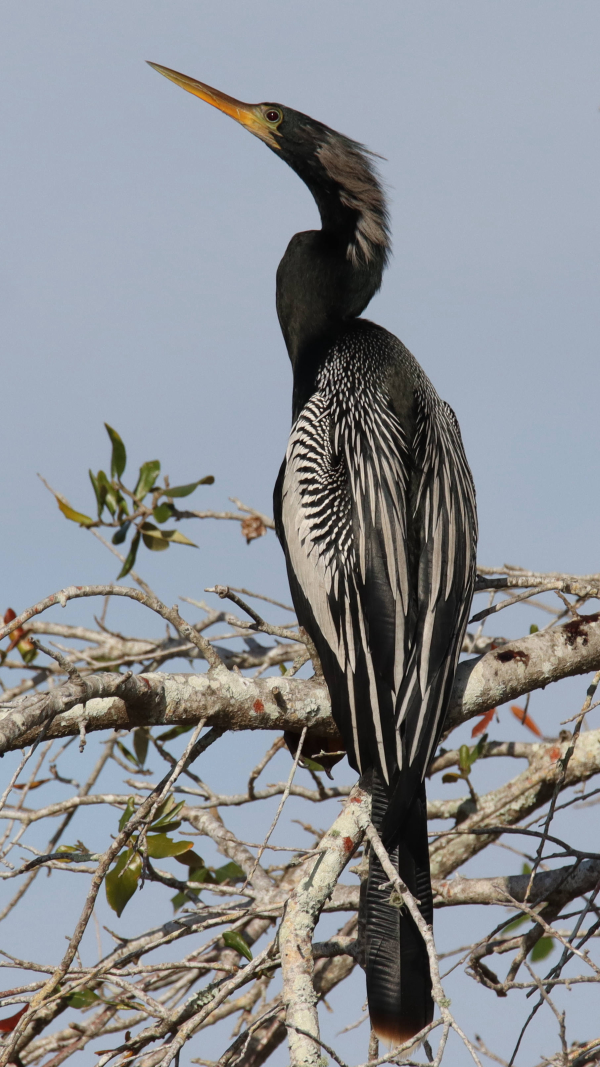
Although this adult Anhinga was present regularly at the church ponds, it may have been the least trusting of the variety of birds photographed there; it was also one of the only Anhingas encountered during this visit (600mm zoom, f-8 aperture, 1/1600 shutter speed, ISO 400).
|
I’ve already had the pleasure to share 3 Bird Photography articles that featured birds I found in the Tampa area, each illustrated with a series of interrelated images. But I was left with a number of quality images of birds I don’t get to see very often that I think are more representative of photos anyone might take during a short visit to Florida, a nice mix of birds.
Florida is a special place for all bird photographers, but it’s an especially good place for beginners to improve and practice, and become more confident in their photo choices and technical settings. Just what we all need! Florida birds also offer beginners with a great variety of waterbirds and wading birds that are larger in size, therefore they are easier to find and photograph. They are usually located in open wetland edges that often provide clear watery backgrounds – another plus – and they tend to be bigger birds that don’t always require a high-magnification lens.
Something else that became immediately clear was that birds in Florida seem to be more trusting than almost anywhere, whether they are wading birds, waterbirds, shorebirds, raptors, or songbirds. I share these insights as someone who has spent extended periods birding in the Sunshine State every 2 or 3 years. As for conditions, winter is a great time to appreciate the warm weather with lots of sunshine, but March and April might be even better months as many wading birds become more colorful, with more vivid facial colors and lacey plumes added to their regular plumage.
Having limited my travels to the greater Tampa area, I emphasized photographing locally and there was one location in particular that provided exceptional neighborhood bird photography opportunities for wading birds and waterbirds – the small shallow wetlands that surrounded my sister Rose’s church, just 2 miles down the road from Jim and Rose’s home.
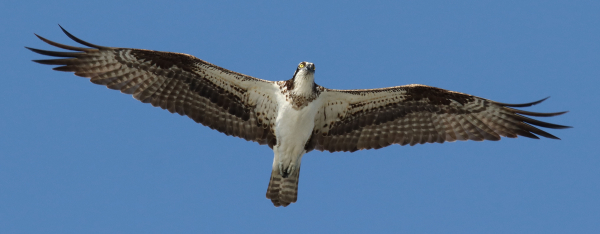
The full length of a gliding Osprey’s wingspan is exciting to document in the moment. Rarely seen in the Great Plains, Ospreys were a common sight in the Bay areas of Tampa (500mm zoom, f-8 aperture, 1/640 shutter speed, ISO 400).
In fact, 4 of the 6 photos that illustrate this article were taken on the beautifully manicured church property – the images of the Common Gallinule, Anhinga, Tricolored Heron, and Florida Sandhill Crane were taken there, along with many other photos of many other species.
The Local Congregation
I already described the church wetlands in my Editor Afield article a couple weeks ago in the February 15 issue of The Birding Wire, which shows several additional bird photos I took there. Just the same, it’s important to provide a short refresher about this surprising little bird photography hotspot:
The beautiful new church is centered on an extensive acreage accented by 6 small ponds, of which 3 were regularly used by birds while I was there. One pond attracted an ever-changing mix of species including an especially surprising assortment of water-oriented birds. Measuring maybe 300 feet long and 100 feet wide and surrounded by mowed grass, the shallow open waters have a central outcrop of cattails and reeds. It’s a pretty wetland with an avifauna based by territorial Common Gallinules, a few Mottled Ducks and Blue-winged Teal, and an adult Anhinga.
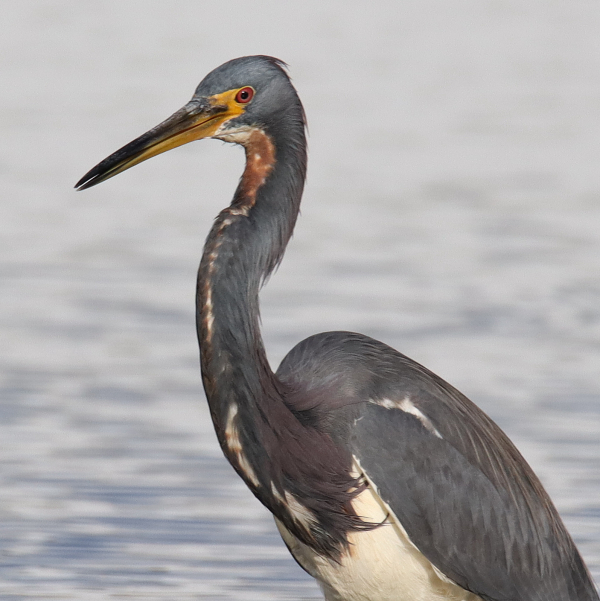
The eye of a fish hunter shows prominently in this close look at a Tricolored Heron. Showing advanced plumage coloration as the nesting season approaches this heron was quite animated at times, but the action photos didn’t make the final edit to appear here (photo info: 600mm zoom, f-7 aperture, 1/2000 shutter speed, ISO 400).
With those species predictably present, others come and go, mostly as individuals: a Tricolored Heron, Little Blue Heron, Florida Sandhill Crane, Snowy Egrets, a Great Blue Heron, White Ibis, Cattle Egrets, a Great Egret, Mallards, American Coots, and regular flocks of Glossy Ibis. After sunset, overnight guests include 3 Wood Storks, the Florida Sandhill Crane, and some evenings an adult and a near-adult Roseate Spoonbill arrive. There are many, many ponds in the area, but none attract such a variety or density of birds as this beautiful little pond!
The close proximity of the church ponds permitted me to break away from my editorial work periodically to see what birds were present and what birds I could photograph. The church birds were pretty trusting, as long as I stay in my car. So luckily, there is an access lane from the street to the church parking lot along the south side of this active marsh, which provided a best-case scenario for photographing birds with the sunlight coming from a southerly direction throughout the winter days. I often parked on the side of the lane to photograph whatever species were in the pond or adjacent to it during a given 10 minute period – and every 10 minutes a new bird or birds arrived to keep the congregation fresh. Church activities were mostly limited to Sunday mornings, Tuesday mornings, and Wednesday evenings, so any other time I often was the only person/car at the property, so didn’t disturb anyone and wasn’t disturbed by anyone.
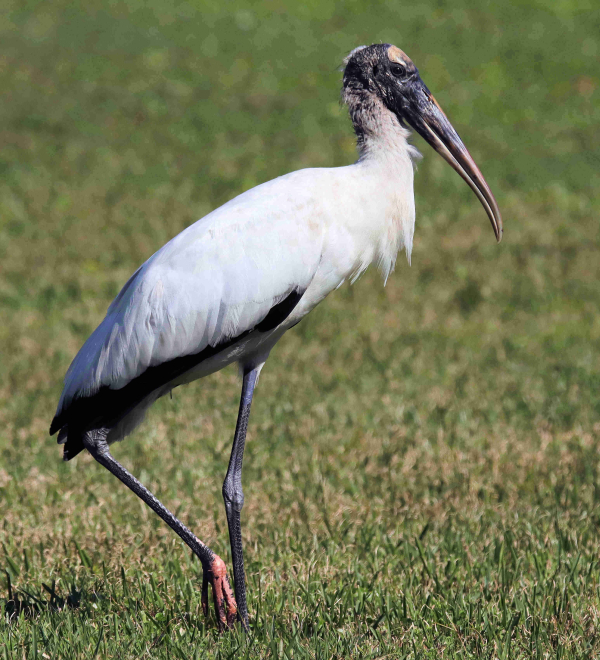
Among the first Wood Storks to arrive at a north Tampa nesting rookery, this adult shows the huge beak indicative of the species (350mm zoom, f-8 aperture, 1/2500 shutter speed, ISO 400).
The reason I emphasize my time at the church pond is that it represents the kind of overlooked gem of a photo site we all need for easy access close to home. I have many hotspots like this near my Dakota home, but they tend to last for a short time, and I’m guessing the church ponds provide a more year-round attraction for many birds, especially considering that many of the birds I encountered there were non-migratory.
Whether it’s a short-lived hotspot or one you can count on seasonally or even year-round, any time you can find and photograph an ever-changing mix of birds, appreciate it, protect it, and enjoy photographing the birds. For now, see what kind of a mix of birds you can photograph during the next 2 weeks, at one location or at many sites. Make it a fun incentive to spend more time outdoors, listening to and observing birds, and creating a personal mix of photos that you take, edit, and share with others. It’s all a wonderful part of birding with your camera. Good Luck!
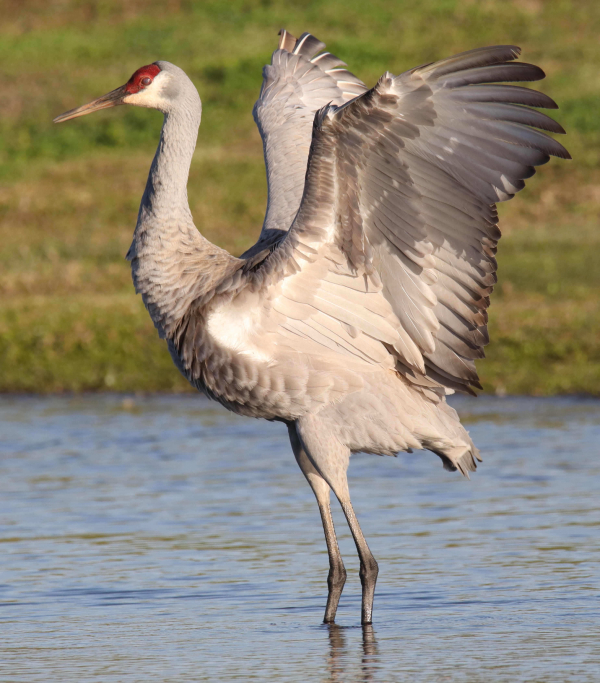
Knowing a wing flap would be a part of finishing a preening session, Paul waited for the Florida Sandhill Crane to show the expanse of its wing-loading capabilities to take this photo (550mm zoom, f-7 aperture, 1/1250 shutter speed, ISO 400).
Article and photographs by Paul Konrad
Share your bird photos and birding experiences at editorstbw2@gmail.com